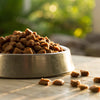How Often to Feed a 2 Month Old Puppy: A Comprehensive Guide for New Pet Parents
- Houndsy
Table of Contents
- Introduction
- Understanding Puppy Nutrition
- How Often Should We Feed Our 2-Month-Old Puppy?
- Feeding Tips for 2-Month-Old Puppies
- Common Mistakes to Avoid
- Conclusion
- FAQs
Introduction
Welcoming a new puppy into our lives can be one of the most joyous experiences. Did you know that puppies grow rapidly during their first few months? In fact, they can gain up to 5% of their body weight daily! This rapid growth means that proper nutrition is crucial, especially for a 2-month-old puppy. As new pet parents, we often find ourselves asking, "How often should I feed my 2-month-old puppy?" Understanding the right feeding schedule is essential not only for your puppy's physical health but also for establishing a solid routine that benefits both of you.
In this blog post, we’ll explore everything you need to know about feeding your 2-month-old puppy, from how often to feed them to the best types of food. By the end, you’ll have a clear understanding of how to ensure your pup gets the nutrition they need for healthy growth and development. We'll also share our insights on how our flagship product, the Houndsy Kibble Dispenser, can elevate your feeding experience, making it both convenient and aesthetically pleasing in your home.
Understanding Puppy Nutrition
The Importance of Proper Nutrition
When we think of nutrition for puppies, it’s important to remember that they have specific dietary needs that differ from adult dogs. Puppies require a diet rich in high-quality proteins, fats, vitamins, and minerals to support their rapid growth and development. Feeding them the right amount at the right times is crucial for preventing issues like obesity, malnutrition, or developmental problems.
Key Nutritional Needs for 2-Month-Old Puppies
At 2 months old, puppies are transitioning from their mother’s milk to solid food. This transition is significant, as it sets the foundation for their future dietary habits. Here are some key nutritional components essential for your puppy:
- Protein: Essential for muscle growth and repair. High-quality puppy food should have protein as the first ingredient.
- Fats: Provide necessary energy and support brain development. Look for foods with good sources of fats, such as fish oil or chicken fat.
- Vitamins and Minerals: These are crucial for overall health and development. Calcium and phosphorus are particularly important for bone growth.
- Digestibility: Puppies have sensitive digestive systems, so it's important to choose food that is easily digestible.
Choosing the Right Puppy Food
When selecting food for your 2-month-old puppy, opt for specially formulated puppy food rather than adult dog food. Puppy food is designed to meet their unique growth needs. Look for premium brands that list high-quality protein sources first on their ingredient list and ensure that the food is free from fillers like corn and wheat.
How Often Should We Feed Our 2-Month-Old Puppy?
Recommended Feeding Schedule
At 2 months old, puppies should ideally be fed four meals a day. This frequency helps to maintain their energy levels and supports their fast metabolism. Here’s a suggested schedule:
- Meal 1: 7:00 AM
- Meal 2: 11:00 AM
- Meal 3: 3:00 PM
- Meal 4: 7:00 PM
Feeding your puppy at consistent times helps establish a routine, which is beneficial for their digestion and overall behavior.
Portion Control
While feeding frequency is essential, so is the amount of food given at each meal. Most puppy food brands provide feeding guidelines based on your puppy's weight. For a 2-month-old puppy, the total daily amount should be divided into the four meals.
For instance, if the food label suggests a total of 1.5 cups per day for a puppy of that age, we would divide that into four meals, giving approximately 0.375 cups per meal. However, always monitor your puppy’s body condition and adjust portions accordingly.
Signs of Proper Feeding
How do we know if we’re feeding our puppy the right amount? Here are some indicators:
- Weight Maintenance: Your puppy should be gaining weight steadily, not losing or gaining excessively.
- Energy Levels: A well-fed puppy will be active and playful, rather than lethargic.
- Stool Quality: Regular, firm stools indicate good digestion. If stools are too soft or too hard, it may be a sign of overfeeding or an unsuitable diet.
Feeding Tips for 2-Month-Old Puppies
Transitioning to Solid Food
If you recently brought your puppy home from a breeder or shelter, they may still be transitioning from their mother’s milk. Start by introducing high-quality puppy food mixed with water or puppy formula to make it easier for them to chew and digest. Gradually reduce the amount of liquid over time.
Avoiding Overfeeding
While puppies have big appetites, it’s crucial to avoid overfeeding. Too much food can lead to digestive upset or obesity. If your puppy consistently leaves food in their bowl, it may be a sign that we’re offering too much.
Establishing a Routine
Consistency is key when it comes to feeding. Establishing a routine not only helps with digestion but also makes potty training easier. Puppies are more likely to eliminate after eating, so having a predictable feeding schedule helps us anticipate when they need to go outside.
Using the Right Feeding Equipment
To make the feeding experience more enjoyable for both us and our puppy, consider using the Houndsy Kibble Dispenser. With its mid-century modern design, ergonomic crank for easy dispensing, and perfect portion control, it simplifies meal times while enhancing our home’s aesthetics. Our dispenser holds 25–30 lbs of kibble and features a BPA-free liner to keep food fresh.
Explore the Houndsy Kibble Dispenser here!
Common Mistakes to Avoid
Free-Feeding
Leaving food out all day can lead to picky eating habits, obesity, and difficulty with house training. Instead, stick to scheduled meal times and remove any uneaten food after 20 minutes.
Ignoring Portion Sizes
As outlined earlier, it’s essential to monitor how much we feed our puppies. Always refer to the feeding guidelines on the puppy food packaging, but also adjust based on our puppy's unique needs and growth patterns.
Feeding Human Food
While it’s tempting to share our meals with our furry friends, many human foods can be harmful to dogs. Stick to dog-safe treats and avoid giving table scraps, which can lead to imbalanced nutrition.
Conclusion
Feeding a 2-month-old puppy is an exciting journey that requires attention to detail and a commitment to their health. By establishing a proper feeding schedule, choosing high-quality food, and monitoring our puppy’s growth, we can ensure they thrive during this crucial stage of development. Remember to be patient, as puppies are learning and growing at a rapid pace.
As we embrace this new chapter with our puppy, we can make mealtimes even more enjoyable with the Houndsy Kibble Dispenser. Designed for convenience and aesthetic appeal, it’s the perfect addition to our pet care routine.
If you have any further questions about feeding schedules or puppy nutrition, feel free to explore our product page or reach out to your veterinarian for personalized advice.
FAQs
How often should an 8-week-old puppy eat?
An 8-week-old puppy should be fed four times a day to maintain energy levels and support proper growth.
What type of food is best for a 2-month-old puppy?
High-quality puppy food, specially formulated for growing dogs, is ideal. Look for brands that list meat as the first ingredient and avoid fillers.
How do I know if I'm feeding my puppy the right amount?
Monitor your puppy’s weight, energy levels, and stool quality. If they are gaining weight steadily and are active, you're likely feeding them correctly.
Is it okay to give my puppy table scraps?
It's best to avoid giving table scraps, as many human foods can be unhealthy or toxic to dogs. Stick to dog-safe treats.
Can I switch my puppy's food suddenly?
No, switching food abruptly can upset your puppy’s stomach. Gradually mix the new food with the old over a week to ease the transition.
Explore our Houndsy Kibble Dispenser to simplify your pet feeding routine and enhance your home decor! Order Now.












